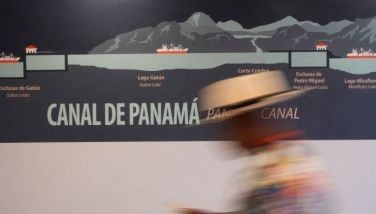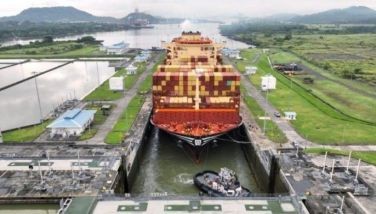Mitigating disasters - everyone's responsibility

Definitely not one of the worst disasters in the country, but still a disaster that claimed at least 10 lives: This is the tale of the 23-year-old SuperFerry 9, first launched in Japan in 1986, and introduced by Aboitiz Transport System Corp. for domestic ferry service in its local operations in 2006.
Before it listed and sank last Sept. 6, SuperFerry 9 already had a checkered performance history while traversing Philippine waters. In 2006, while travelling from Bacolod City to Manila, it encountered engine problems and needed to be repaired at sea from more than a day.
The following year, the ship was delayed once again at Negros Island while on its way to Iligan City from Bacolod City due to engine problems. Four months ago, the ship suffered yet again from engine problems that caused 900 passengers to be stranded off Camiguin.
There was no engine problem that could immediately be linked to the pre-dawn listing of SuperFerry 9, at least, according to initial reports by Aboitiz. An investigation is currently ongoing to establish the possible reason for the vessel’s behavior.
Meantime, it is but right that Maritime Industry Authority (MARINA) should suspend the operations of Aboitiz to protect the riding public from these “floating coffins.”
Reluctance to abandon ship
So far, a total of 961 crew members and passengers have already been accounted for, people who had survived through sheer luck or through the quick response of government and the owner-company’s rescue operations. It helped a lot that the weather and seas were calm.
Those who did not make it, and the scores who were injured, reflect an alarming level of unpreparedness, not only by the crew and staff of the sunken ship, but of millions of Filipinos who rely on sea and river ferrying transportation services to get to their desired destinations.
According to several first-hand accounts, many passengers – mostly women and children – were hesitant, or downright refusing, to abandon ship even if this just meant going down the many rescue boats that came to assist in the evacuation – all because they did not know how to swim.
For those who died of drowning with their life jackets on, not being mentally prepared on how to act and respond when faced with an ‘abandon ship’ order could have spelt out why they panicked, and eventually perished.
12th unsafest place
Already, the Philippines ranks as the 12th “unsafest place on earth” according to a recently released risk report by the United Nations’ International Strategy for Disaster Reduction. Nearly a quarter of a million people were killed due to natural and man-made disaster occurrences in 2008, the second biggest annual toll of the past decade related to casualties in disasters.
For an archipelago of more than 7,000 islands, seafaring continues to play a dominant role in our countrymen’s travel habits. Being in a part of the world frequently visited by typhoons, encircled by a belt of active volcanoes and fault lines, and therefore prone to earthquakes and volcanic eruptions, disaster management and mitigation should be high up on the government’s agenda.
Not surprisingly, the first time that most Filipinos get to wear a life jacket is when they are in the midst of a pending disaster. How many of our children have actually been trained to put on a life jacket? How many have learned how to swim? How many have gone through a disaster drill involving ship or boat accidents?
Perhaps, our lawmakers should consider pushing for the immediate inclusion of disaster mitigation and preparedness in our education curriculum while continuing to harp on the need for all local government units to set up their own respective responses and procedures.
Shipping companies should also make it their business to encourage the hands-on training of passengers in basic life-saving techniques and the ABCs of what to do when accidents occur. This goes without saying that their personnel must be fully trained on how to react during crises.
We cannot afford to have shipping crew who are not able to facilitate the orderly evacuation of a sinking vessel. With 112 crew members aboard SuperFerry 9 to about 800 passengers, any deaths could have been avoided if each ship staff knew what to do.
More natural disasters in the horizon
Aside from being prepared to handle shipping accidents, a more comprehensive disaster management program needs to be put in place especially now that the United Nations has raised a warning of bigger natural disasters arising from climate change.
Data shows that between 1970 and 2000, the Philippines had incurred an average annual direct damage of P15 billion yearly, an equivalent of about 0.7 percent of gross domestic product (GDP), because of natural disasters.
During the same period, an average of 866 lives was lost annually, with typhoons accounting for 65 percent of the deaths. Typhoons alone kill an average of over 500 people every year and about P4 billion are lost due to tropical cyclones.
Climate change will be the country’s biggest problem this century as scientific evidence on changing climates is stronger than ever. The number of hurricanes globally has doubled, affecting heavily people in developing countries.
With global warming, we are experiencing an increase in both frequency and intensity of extreme weather events: more prolonged droughts, floods, landslides, heat waves, and more intense storms, and the spread of insect-borne diseases such as malaria and dengue.
At risk are crop yields that are vulnerable to droughts or downpours and changes in timing and reliability of rainy seasons. Most importantly, the country is extremely at risk to the sea level rise of several cm per decade, which will affect coastal flooding, water supplies, tourism, fisheries etc.
There is no time to dilly-dally.
Update on 2009 Philippine Collegiate Championship Games
Seven teams are securely in place in the “Sweet 16” Finals of the 2009 Philippine Collegiate Championship. These are Ateneo de Manila Blue Eagles, FEU Tamaraws, University of the East Warriors, UST Golden Tigers from the UAAP and from NCAA, San Sebastian College-Recoletos Stags, San Beda Red Lions and the JRU Heavy Bombers.
Letran Knights and the Arellano University Chiefs are still battling it out for the last slot reserved for NCAA teams. At Cebu City, the Webmasters of University of Cebu are leading the pack for the CESAFI championship and an automatic entry into the elite “Sweet 16” finalists.
The 5th and 6th rank teams from the UAAP and NCAA still have the opportunity to advance to the “Sweet 16” Finals. The 5th rank teams from UAAP and NCAA, for instance, will advance to the VisMin–Metro Manila zonal qualifying games to be held at Cebu City on Nov. 4 to 8, 2009.
On the other hand, the 6th rank UAAP team will advance to the South Luzon-Bicol – Metro Manila zonal qualifying games to be held at the Nueva Caceres Gym, Naga City on Nov. 12 to 14, 2009. The 6th rank NCAA team will play in the North-Central Luzon – Metro Manila zonal qualifying games to be held in Metro Manila on Nov. 9 to 12, 2009.
Watch this space for updates on the 2009 Philippine Collegiate Championship Games or visit www.CollegiateChampionsLeague.net.
Should you wish to share any insights, write me at Link Edge, 25th Floor, 139 Corporate Center, Valero Street, Salcedo Village, 1227 Makati City. Or e-mail me at [email protected]. For a compilation of previous articles, visit www.BizlinksPhilippines.net.
- Latest
- Trending



























